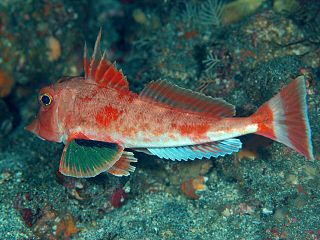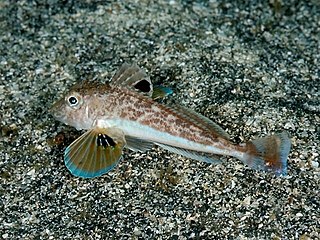
Triglidae, commonly known as gurnards or sea robins, are a family of bottom-feeding scorpaeniform ray-finned fish. The gurnards are distributed in temperate and tropical seas worldwide.

Peristediidae, the armored sea robins or armoured gurnards, is a family of ray-finned fishes belonging to the suborder Platycephaloidei in the order Scorpaeniformes. They are found in the deep water in the tropical and warm temperate of the world's oceans.

The scaly gurnard is a species of marine, demersal ray-finned fish from the family Triglidae, the gurnards and sea robins. It is found in the south-western Pacific Ocean.

Bellator militaris, the horned sea robin, is a species of marine ray-finned fish belonging to the family Triglidae, the sea robins. This fish is found in the western Atlantic Ocean.

The spiny red gurnard is a species of marine ray-finned fish belonging to the family Triglidae, the gurnards and sea robins. This species is found in the northwestern Pacific Ocean where they occur at depths of from 25 to 615 metres. This species grows to a length of 40 centimetres (16 in) TL. This species is of commercial importance as a food fish.

Bellator egretta, the streamer searobin, is a species of marine ray-finned fish belonging to the family Triglidae, the sea robins. This fish is found in the western Atlantic Ocean.

Lepidotrigla is a genus of marine ray-finned fishes belonging to the family Triglidae, the gurnards and sea robins. These gurnards are found in the Eastern Atlantic, Indian and Western Pacific Oceans.

The Eastern spiny gurnard is a species of marine, demersal ray-finned fish from the family Triglidae, the gurnards and sea robins. It is endemic to Australia.

The piper gurnard, also known as the piper or the lyre gurnard, is a species of marine, demersal ray-finned fish from the family Triglidae, the gurnards and sea robins. It is found in the eastern Atlantic Ocean and the Mediterranean Sea. It is the only species in the monotypic genus Trigla.

The jaggedhead gurnard is a species of marine ray-finned fish belonging to the family Peristediidae, the armoured gurnards or armored searobins. This species is found in the eastern Indian Ocean and the western Pacific Ocean. It is the only known member of its genus.
Heminodus is a genus of marine ray-finned fish belonging to the family Peristediidae, the armoured gurnards or armored sea robins. It is currently considered to be a monotypic genus, its only species being Heminodus philippinus.
The lesser gurnard, or Quekket's gurnard, is a species of marine ray-finned fish belonging to the family Triglidae, the gurnards and sea robins. This species is found in the southwestern Indian Ocean and marginally in the southeastern Atlantic Ocean. This species is of commercial importance as a food fish.

Lepidotrigla guentheri is a species of marine, demersal ray-finned fish from the family Triglidae, the gurnards and sea robins. It is found in the Northwestern Pacific Ocean.

Lepidotrigla kishinouyi, the devil sea robin, is a species of marine, demersal ray-finned fish from the family Triglidae, the gurnards and sea robins. It is found in the northwestern Pacific Ocean.

Peristedion greyae, the alligator searobin, alligator armored searobin or prickly armoured sea robin, is a species of marine ray-finned fish belonging to the family Peristediidae, the armoured gurnards or armored sea robins. It is found in the western central Atlantic.

Pterygotrigla arabica is a species of ray-finned fish belonging to the family Triglidae, the gurnards and sea robins. This fish is found in the northern Indian Ocean.

Pterygotrigla polyommata, the latchet, butterfly gurnard, flying gurnard, lachet gurnard, pastry, sharpbeak gurnard, spiny gurnard or spinybeak gurnard, is a species of marine ray-finned fish belonging to the family Triglidae, the gurnards and sea robins. It is found in the southeastern Indian and southwestern Pacific Oceans.

The blackspotted gurnard, also known as the half-spotted gurnard, is a species of marine ray-finned fish belonging to the family Triglidae, the gurnards and sea robins. It is found in the Indo-Pacific region.

The large-scaled gurnard is a species of marine, demersal ray-finned fish from the family Triglidae, the gurnards and sea robins. It is found in the eastern Atlantic Ocean and the Mediterranean Sea.

Lepidotrigla spiloptera, the spotwing gurnard, spotfin gurnard or red-fringed gurnard, is a species of marine, demersal ray-finned fish from the family Triglidae, the gurnards and sea robins. It has a wide Indo-Pacific distribution.


















